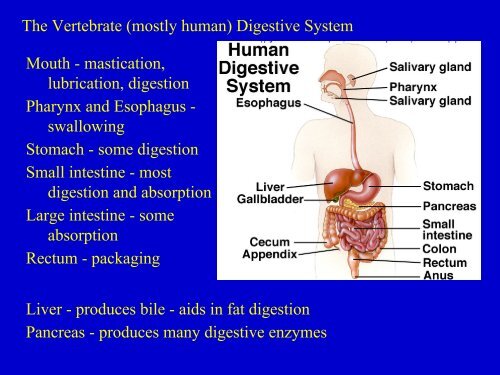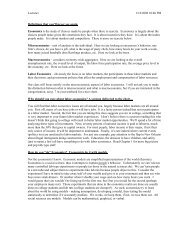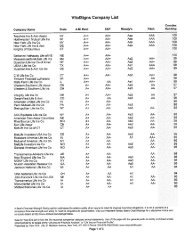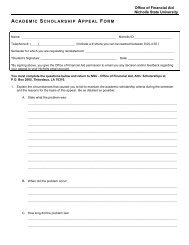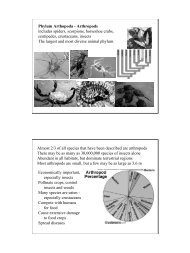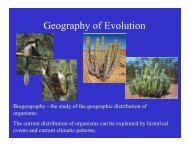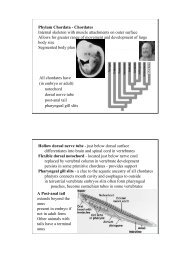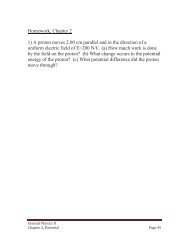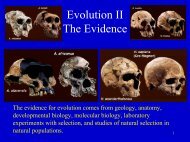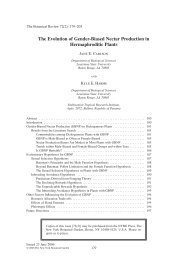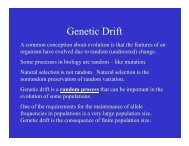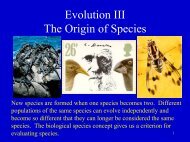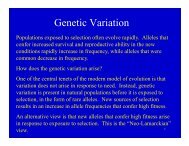The Vertebrate (mostly human) Digestive System Mouth ...
The Vertebrate (mostly human) Digestive System Mouth ...
The Vertebrate (mostly human) Digestive System Mouth ...
- No tags were found...
Create successful ePaper yourself
Turn your PDF publications into a flip-book with our unique Google optimized e-Paper software.
<strong>The</strong> <strong>Vertebrate</strong> (<strong>mostly</strong> <strong>human</strong>) <strong>Digestive</strong> <strong>System</strong><strong>Mouth</strong> - mastication,lubrication, digestionPharynx and Esophagus -swallowingStomach - some digestionSmall intestine - mostdigestion and absorptionLarge intestine - someabsorptionRectum - packagingLiver - produces bile - aids in fat digestionPancreas - produces many digestive enzymes
Gastrointestinal tract has a layered structureLumen - interior spaceMucosa - innermost layerof epitheliumSubmucosa - connectivetissueMuscularis - double layerof smooth musclecircular and longitudinalSerosa - connective tissuecovers exteriorNerve plexuses - insubmucosa, regulateactivitiesGlands - in submucosa and outside serosa - secrete substances intolumen
<strong>The</strong> <strong>Mouth</strong><strong>The</strong> teeth cut and grind food - masticationTongue mixes food with salivaSalivary glands produce saliva - empty through mucosa of mouthsalivary amylase initiates breakdown of starchSecretion of saliva controlled by the nervous systemlow level continuous secretion keeps the mouth moisthigh level secretion stimulated by sight, smell, or idea of food
SwallowingFood passes to the back of the mouthPalate elevates, pushes against rear of pharynxSeals off nasal cavity - a good thingPressure on pharynx stimulates swallowing center in brainSwallowing center inhibits respiration - a good thingSeals trachea - raises larynx and closes glottis withepiglottis
EsophagusUpper 1/3 of esophagusenveloped in voluntaryskeletal muscleLower 2/3 enveloped ininvoluntary smoothmuscleFood propelled byperistaltic waves ofmuscular contractionsEntry of food into stomach controlled by gastric sphincter -prevents food in stomach from re-entering esophagus
StomachSack-like, thick walled, muscular,with highly convoluted interior mucosasmooth muscle churns foodGlands in mucosaproduce secreteseveral compounds
Parietal cells secrete HCl and intrinsic factor (for B 12 absorption)Chief cells secrete pepsinogen, an inactive proteaseActive proteases in stomach activate pepsinogen to pepsinDigestion in stomach restricted to protein digestionproteins reduced to smaller polypeptidesHCl aids protein digestion by denaturing proteinsStomach produces 2 lgastric secretions/dayStomach pH = 2No digestion ofcarbohydrates or fats<strong>The</strong> acidic food mixtureproduced in the stomachis called “chyme”
Little absorption occurs in stomach - some water, alcohol, aspirinChyme leavesstomach and entersduodenum throughpyloric sphincterCapacity ofduodenum is smallcompared to stomachRate of dumpingcontrolled bynervous system andhormones
Small Intestineabout 6 m longcomposed of three sections - duodenum, jejenum, ileummost digestion occurs in duodenum and jejunumDuodenum is 25 cm long - remainder is jejenum and ileumreceives chyme, pancreatic enzymes, bile from liverEpithelial wall hasmany folds - villiVilli have cytoplasmicprojections-microvilliBoth increase surfacearea for absorption andsecretion
Epithelial wall also called “brush border”Brush border has embedded enzymes thathydrolyze lactose, sucrose and othersugars
Accessory OrgansPancreasPancreas - at junction ofstomach and small intestineConnected via pancreatic ductHas both exocrine andendocrine functionsFluid contains many enzymesproteases (trypsin andchymotrypsin)pancreatic amylase andfat digesting lipaseEnzymes released as inactive zymogens,activated by brush border enzymesFluid also contains bicarbonate to neutralize HClChyme in intestine becomes slightly alkaline
Absorption in the Small IntestineAmino acids and simplesugars transported acrossbrush border - throughepithelial cells and intocapillaries within villiBlood carries digestionproducts to liver -via hepatic portal vein
Fats hydrolyzed into fattyacids and monoglyceridesAbsorbed by intestinalepithelium andreassembled intotriglyceridesNew fats combined withproteins to form watersolublechylomicronsAbsorbed into lymphaticcapillariesContents of lymphaticsystem enter blood streamin veins near neck
Each day 9 liters of chyme passes small intestineNearly all fluids and solids are absorbed8.5 liters absorbed in the small intestine350 milliliters reabsorbed in the large intestine50 grams of solids and 100 milliliters of liquid leave as feces
Large Intestine (colon)Has no digestive functionabsorbs 4% of fluidsSurface lacks villiabout 1 m longHarbors symbiotic bacteriaAbsorbs sodium, vitamin K,other products of bacterialmetabolismSmall intestine empties intolarge intestine throughileocecal valve just abovececum and appendixPrimary function is to compact and store fecesBacteria are incorporated into fecesBacterial fermentation produces gas
Human colon evolved to process food with high cellulose contentLow fiber diets result inslower passage of foodthrough colonMay be associated withhigh level of coloncancer in U. S.
<strong>The</strong> rectum - terminal portion of the large intestineFeces pass into rectum by peristaltic contractionsMaterial exits anus through two sphinctersFirst sphincter is smooth muscle, opens involuntarilySecond sphincter is striated muscleunder voluntary control - a very good thing
Accessory OrgansPancreas - at junction ofstomach and small intestineConnected via pancreatic ductHas both exocrine andendocrine functionsFluid contains proteases(trypsin and chymotrypsin)pancreatic amylase andfat digesting lipaseEnzymes released as inactive zymogens,activated by brush border enzymesFluid also contains bicarbonate to neutralize HClChyme in intestine becomes slightly alkaline
Pancreas is also an endocrine glandProduces hormones that regulate blood sugar levelProduced in islets of Langerhans clustered throughout pancreasMost important pancreatic hormones are insulin and glucagonInsulin - produced by β-cells -released in response to highblood sugarstimulates sugar uptake by liverand muscles - converted toglycogenGlucagon - produced by α-cells -released in response to lowblood sugarstimulates release of sugar fromliver - from stored glycogen
Liver and GallbladderMain secretion of liver is bilea fluid with bile pigmentsand bile saltsBile pigments are waste productsfrom destruction of red blood cellsBile salts are lipid and water solubleEmulsify fatsAllows faster digestion of fatBile is stored and concentrated in gall bladderFatty food in duodenum triggers contraction of gallbladder torelease bileContraction of gallbladder may result in pain under right shoulderblade
Regulatory Functions of the LiverHepatic portal vein carries blood from stomach and intestine to liverLiver absorbs or chemically modifies substancesAlcohol, drugs, toxins metabolized by liver cellsAmmonia from intestinal bacteria converted into ureaControls level of many substances produced by bodySteroid hormones converted into less active formsTerminal products of metabolism eliminated in feces or throughkidneysProduces proteins found in blood plasmaIncludes most blood clotting factorsMaintains blood protein concentrationwithin narrow limits
Neural and Hormonal Regulation of DigestionNervous ControlSight/Smell of food stimulates salivary and gastric secretionsHormonal ControlFood in stomachstimulates secretion ofgastrin by stomachGastrin stimulatessecretion ofpepsinogen and HClLow stomach pHreduces secretion ofgastrin
Passage of chyme from stomach inhibits stomach contractionsProcess mediated by neuralimpulses andenterogastrone proteinsGastric inhibitory peptide(GIP) is one enterogastroneGIP released by duodenumProduction stimulated moststrongly by fat in chymeCholecystokinin (CCK) is secreted in response to fat in chymeStimulates contraction of gallbladder to release bileSecretin released in response to low pH chymeStimulates pancreas to release bicarbonate and enzymes


